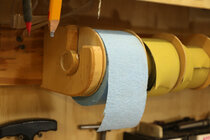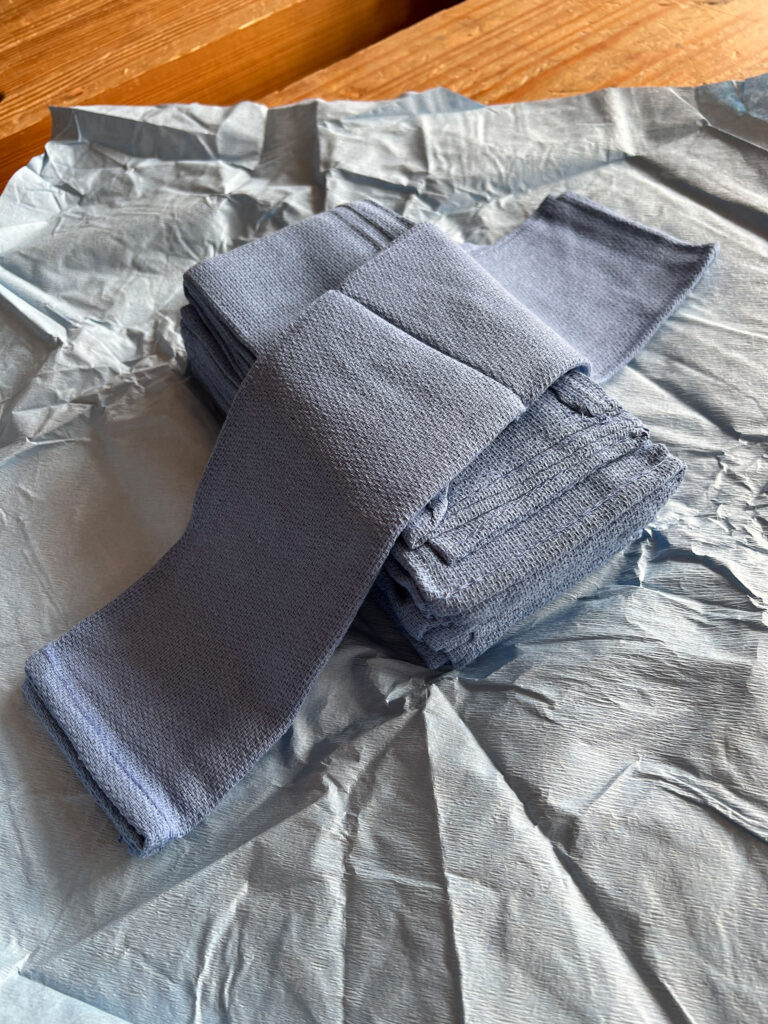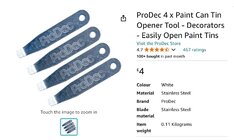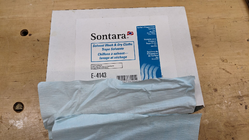Are you sure it's your cloth that produces the nits? I had a terrible time with little nits showing up in the finish and have learned a couple tricks.
First, I have an old house with lots of airborne debris. The faster a film finish sets, the less stuff settles into it. Oil finishes are mostly unaffected. Some folks have gone to placing their just finished piece inside a box or under a cover to deal with this issue.
Second, the finish itself produces a lot of the nits. Someone suggested putting the finish on one side of the cloth, then using the other side or refolding it, to get a clean, wet side on the wood. The cloth then acts like a filter, straining bits of crusty or congealed finish out before it can hit the surface. This makes a huge difference for me. Using older finish would be a contributor to this problem, as well.
Third, wiping off the project with a cloth, even a tack cloth, doesn't reliably get all the sanding dust off. I tried wiping with alcohol, but this didn't seem to help much in my hands. A friend suggested blowing the piece off with compressed air prior to applying finish, and this helps, especially on pieces with knots or checks or bark inclusions.
As for the cloth, I use old t-shirts, ripped rather than cut (like making staves instead of rip sawing) at my quilter wife's suggestion. Making a nick in the edge of the fabric and tearing allows the fabric to come apart between two strands and produces less lint. Folding the cloth to keep the edges from contact with the wood may help, too.
This is a great question. Today, the answer is yes, I'm pretty sure. There could be occasions where its finish nits, I've had that problem in the past before I understood how finish can get stuck in sandpaper then ball up if you keep using those gummed up parts. I also have a fair amount of dust collection and air filtration in my shop, and do a pretty good job of capturing most of the dust as its created, and the rest should be captured by the air filter. I am using a shop vac, but, most of my turnings are smallerish, maybe medium sized, so I'm not creating tremendous amounts of dust...yet. A proper dust collection system IS in my future, hopefully the not too distant future.
I tried tack cloths in the past too... I did not really like them. It may depend on what brand you use...the brands I used, were very waxy and almost felt "wet" (for lack of a better term?) and felt they left a residue behind...even when just 'dabbing' with them. Alcohol definitely didn't work. Blowing seems to be a double-edged sword...it will get some of the junk, but also can embed metallic fragments even deeper. I haven't used tack cloths in a while. I've also stopped using steel wool, which was the main reason I started using tack cloths...because the bits of steel seem to get stuck in the grain, no matter how much effort I put into preventing that. The wood then looks "dirty" as a result...never liked that. These days, I just sand, maybe use the white 3M pads, although the pads are now largely being phased out in favor of just picking up a large pinch of shavings and wood dust and using that to burnish the surface, which I find works a lot better, and leaves a much better surface, than sanding alone or the pads. I have some of the metal fiber based pads as well, but, I had the same problem with them as I did with the steel wool... I do use compressed air to clean off wood dust after I sand, or between critical grits. That works well, when its just wood dust, unlike with any steel based substance.
Sanding and otherwise smoothing, burnishing, etc. the wood BEFORE applying finish is actually ok these days. I don't have many problems. The trouble I have is when I start to apply the finishing compounds themselves...even if its just DNA to clean and defat the wood, depending on the material, I still often get fibers or fuzz. That is easy to clean off, once the DNA evaporates. Once I start applying...shellac, or another sealant. Then the actual finish. That's when I usually start having problems. I was trying to find a more durable finish for my pieces earlier in the year, and WOP was one of them. I actually really like it...except the effort to do it well on smallish turned pieces is VERY HIGH, and fibers and fuzz is a problem. I tried using spar urethane applied with a foam brush using a particular technique, and could never quite get the glassy smooth finish I had seen others get and really wanted. I have been working with lacquer...its been hit or miss, but, after talking with some other people on a pen turning forum recently, I think I may soon achieve my goals with lacquer. I guess we will see...at least with the lacquer, there is no NEED for any towel, rag, pad, etc! I get a bit of an orange peel effect with lacquer, which I then have to sand back to level a bit before applying the next coat. I've been told I may be using TOO LITTLE, so I'm working on that.
In the mean time, I've fallen back to my main staple finish: Zinssers Bulls Eye Shellac as a sealer and Acks sanding paste and finishing wax. It does a good job, gives the wood a nice satin luster, and helps bring out some of the chatoyance. Its not as shiny as I would like once the wax has fully cured...it dulls from its initial shine (which is not glossy, but it is shiny.) Hopefully I'll figure out lacquer soon here, and at least be able to add that to my options. Until then, applying the shellac, in particular, is the main area where I just seem to perpetually run into...lint!







